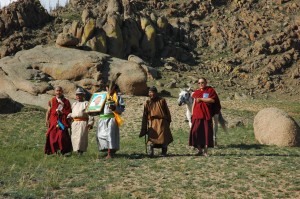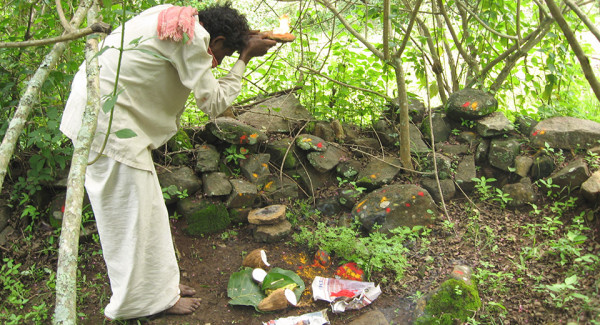
Asian Sacred Amasayithi Natural: Ifilosofi yasendulo yase-Asia nokuzilolonga ngokubaluleka okuyisisekelo ezindaweni ezivikelwe. (landa lolu cingo)

Indawo evikelwe yiMogd Khan yaseMongolia ihlotshaniswa nokuphila kukaGhengis Khan futhi bekulokhu kuyisiza semvelo esivikelekile kuzwelonke kusukela ngaleso sikhathi 1778. Manje iyingxenye yeKhantii Mountain Protended Area ebanzi. Ngemuva kweminyaka eminingi yokucindezelwa kwamakhomanisi, imikhosi ivuselelwe yaholela lamas Buddhist wangakini. Lemikhosi ihlonipha onkulunkulu bezintaba kanye neziicelo ngokumelene nesomiso neqhwa elinamandla. Lapha iqembu elenza inkambiso endaweni engcwele kakhulu yentaba, phezulu, ukubuyisa okuholwa yizindela. Umuntu wesithathu ukusuka kwesobunxele nguMnu. J. I-Boldbaatar, Umqondisi, UKhan Khentii Special Area evikelwe futhi ngakwesokunene sakhe sokuqala sokupaka usuku wanamuhla (bheka ukutadisha kwamacala kuzinkombandlela ze-IUCN UNESCO). Photo: Robert Wild.
Within the context of the Asian Sacred Sites Network Project, IUCN WCPA Japan, the Imvelo Ehlukahlukene Network Japan kanye Sacred Amasayithi Natural Initiative in collaboration with the IUCN WCPA Specialist group on Cultural and Spiritual Values of protected Areas invite abstracts for contributions to a publication and online case studies focused on the modern significance of sacred natural sites in Asian protected areas with reference, where appropriate, to an Asian Philosophy of Protected Areas. We are looking for examples from all protected area governance types; indigenous and community conserved areas, government managed, privately managed and co-managed protected areas as well as different IUCN protected area categories, kusukela; ‘Ia Strict nature reserve’ to ‘VI. ‘Protected area with sustainable use of natural resources’. We are also interested in experiences that describe the implementation of the IUCN-UNESCO Sacred Natural Sites, ImiKhombandlela Protected Area Managers, available in several languages.
As a guide to developing your contribution to the publication you may follow the guiding questions outlined in this call and write freely or base you contribution on the structure provided in the case study template that will be used for developing izifundo ze-inthanethi.
Guiding Questions:
- To what extent do sacred natural sites form the backbone of protected areas in Asia, isb. their cultural, spiritual and philosophical underpinnings?
- What is the modern relevance of sacred natural sites to protected areas and how can this be better recognised and their traditional guardians be engaged?
- How can we improve management effectiveness, governance and equity of sacred natural sites within and outside protected areas in Asia?
Sources of reference:
- I Asian Philosophy of Protected Areas
- I Asian Sacred Natural Sites Network project
- The Best Practice Guideline No16: Sacred Natural Sites – Guidelines for Protected Area Managers,
- IUCN 2008 Ukulungiswa 4.038 Ukuqashelwa nokulondolozwa kwezindawo ezingcwele zemvelo ezindaweni ezivikelwe
- The WCC-2012-Rec-147 Sacred natural sites – support for custodian protocols and customary laws in the face of global threats and challenges.
Publication schedule:
Abstracts or your outline of ideas for your contribution can be submitted untill September, 2014 and should not exceed 400 words. The final manuscripts of approximately 4000 words (excluding references) will be required by November 2014 and should include up to eight good quality illustrations and photos as well as one or two maps. the aim is to have the publication launch coincide with activities on sacred natural sites and protected areas at the World Parks Congress in Sydney Australia.
Online case studies schedule:
Suggestions for online case studies are always welcome. A case study will be around 1000 words and can be based on your contribution to the publication or stand by itself. We aim to develop each chapter contribution to the publication into an online case study and establish cross-references. For examples of Asian case studies see the Asian Sacred Natural Sites Network Project.
Please send your abstracts and bio to info@sacrednaturalsites.org

A Soliga paying his obeisance at Devaru sacred natural site in Biligiri Rangaswamy Temple Wildlife Sanctuary, Karnataka, India. After the declaration of the BRTWS in 1974, new rules have made traditional Soliga practices harder and harder, for example by restricting access to their sacred natural sites. Following a ruling by the country’s Supreme Court in 2006, a near-complete ban was imposed upon the collection of NTFPs within sanctuaries and natural parks. In a response to this, the Soliga GPS’ed and mapped their sacred and cultural sites in the forests of the Biligiri Rangaswamy Temple Wildlife Sanctuary. The topographic sheets with sacred natural sites on it were used to help locate the clan boundaries followed by subsequent visits to ascertain the boundaries of the yelles or sacred natural sites. (Umthombo: Nitin, D Rai.)






